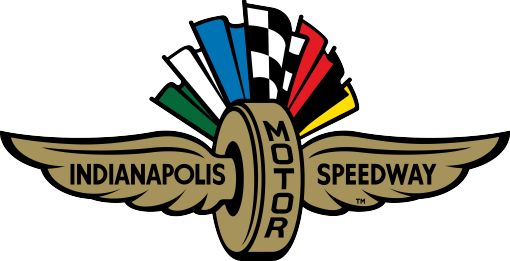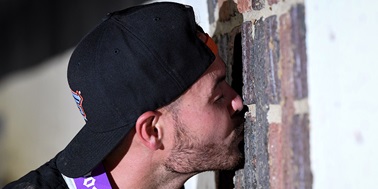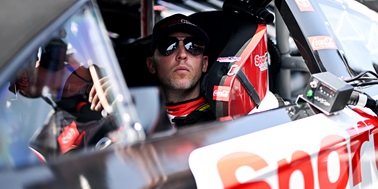2000
Formula One–bound Juan Pablo Montoya became the ninth different first-time starter to win the race.
The Colombian standout, who first saw the Speedway as the lone passenger on a Hall of Fame Museum tour bus on a murky February day in 1999, narrowly missed claiming the pole as well. He was edged out by Greg Ray, who led the first 26 laps, after which Montoya led for 167 of the remaining 174.
2001
Another Speedway "first" took place when, to the delight of the huge crowd, effervescent Brazilian "rookie" winner Helio Castroneves broke with protocol by stopping his car at the start/finish line, leaping from the cockpit and then running across the track to climb the outer fence.
Not only was this the 11th win for Team Penske, but with Gil de Ferran following close behind, it marked (perhaps surprisingly) the first-ever one–two finish by this extraordinary organization.
Race leaders in addition to the Penske pair included Robby Gordon, Greg Ray, Tony Stewart, Michael Andretti, Arie Luyendyk and Mark Dismore.
2002
Helio Castroneves joined an exclusive group of drivers by becoming only the fifth ever to win in consecutive years, thus joining Wilbur Shaw (1939–40), Mauri Rose (1947–48), Bill Vukovich (1953–54) and Al Unser (1970–71).
The truly remarkable aspect of this was that he did it in only two starts, thus remaining undefeated in "500" competition.
First-time starters Tony Kanaan and Tomas Scheckter both were taken out by accidents while leading, Kanaan on his 90th lap and Scheckter while on his 173rd, after having led 85 laps, which was approximately half the distance up to that point.
Paul Tracy was making a spirited attempt at taking the lead when an accident brought out the yellow with just one lap remaining.
2003
French-born Brazilian Gil de Ferran held off a spirited late-race challenge to win, thwarting the attempt by Helio Castroneves to become the first driver ever to win the “500” in three consecutive years.
The 2001 and 2002 winner, who started this race from the pole and led 58 laps, came up just .299 of a second short at the finish. The victory by de Ferran, who led the final 31 laps and had been runner-up to Castroneves in 2001, extended the total of Indianapolis 500 wins by team owner Roger Penske to an amazing 13. While this was the third win for a G-Force chassis, it was the first ever for Toyota as an engine supplier.
Michael Andretti led 28 laps before dropping out with mechanical trouble in what he had announced as his final start. It extended his total of laps led to 426, by far the greatest number ever by a driver who was never able to win.
2004
Rahal Letterman Racing driver Buddy Rice started from the pole and led a field-high 91 laps to win a rain-shortened “500.”
After rain delayed the start of the race by two hours, Rice led the 33-car field to the green flag. He led the first 12 laps, but fell to 16th after stalling the car during a pit stop after the race was red-flagged because of rain.
Timing aided Rice in securing the victory when he exchanged the lead with Adrian Fernandez, who ducked into the pits late in the race. Rice had pitted four laps earlier. Rice then pulled to a 1.4237-second lead over Tony Kanaan when moisture was spotted in Turn 1. A downpour soon followed, and the final six laps were run under yellow. Finally, with light rain falling, Rice took the checkered flag on Lap 180, 20 laps short of a complete race.
2005
Dan Wheldon became the first Briton to win the “500” since Graham Hill in 1966, but most of the attention was focused on a sensational 23-year-old “rookie” named Danica Patrick.
The crowd rose to its feet and a thunderous roar erupted with only 10 laps to go when a late-race caution period ended and race leader Wheldon was out-accelerated by Patrick on the restart. Earlier in the day, during pit stop shuffles on Lap 56, she had become the first female ever to lead the “500.”
She led on three different occasions for a total of 19 laps, and appeared headed for an incredible victory until the sobering reality of a dwindling fuel supply made it necessary for her to relax her pace in order to finish. She managed to salvage fourth place behind Wheldon, Vitor Meira and Bryan Herta, surpassing the ninth-place finish by Janet Guthrie in the 1978 “500” and joining Lyn St. James (1992) as a female winner of the Rookie of the Year award.
There were 27 lead changes between seven drivers, including Sam Hornish Jr., who paced the field for 77 laps but did not finish.
2006
It was perhaps the most remarkable ending ever, with no less than five different drivers leading within the final 18 laps alone.
First, it was Dan Wheldon. Not only did he appear to be on his way to being the sixth to win in consecutive years, but he would have been the first to do so with different teams. Then it was Tony Kanaan leading until a late-race restart resulted in sentimental favorite Michael Andretti being out in front. Would this be the year that Michael, fresh out of retirement, finally scored a long overdue win?
It would not.
He was passed on lap 196 by none other than his own 19-year-old son Marco, who would have been the youngest winner ever had he not been passed within just a couple of hundred yards of the line by a fast-closing Sam Hornish Jr., who seemingly came out of nowhere.
2007
Dario Franchitti was the first to cross the yard of bricks under the yellow/checkered flag combination after the race was halted on Lap 166 due to rain.
It was the second downpour of the day, the first resulting in a nearly three-hour rain delay. Franchitti took the lead from teammate Tony Kanaan after Kanaan pitted on Lap 155.
Franchitti was able to hold off Scott Dixon and Ryan Briscoe until a multi-car accident on Lap 163. While the safety team was cleaning up from the accident, the skies opened once again, and Franchitti took the rain-soaked checkered flag on Lap 166.
2008
Scott Dixon, runner-up to Dario Franchitti in the rain-shortened event of the previous year, moved up one position for the win.
The Australian-born New Zealander led more than half of the event, with 115 laps to his credit, as for the 19th time a driver won the "500" from the pole.
There were 18 lead changes among nine drivers, one of whom was Vitor Meira, who was runner-up for the second time in four races. Third-placed Marco Andretti—still only 21 years of age—led 15 laps, turned the fastest lap of the race (224.037 mph) and made the top three for the second time in only three starts.
2009
The number of drivers who have won the Indianapolis 500 three times or more was increased to nine, with pole winner Helio Castroneves scoring again to raise the incredible record of Team Penske to an unbelievable 15 victories.
There were an unusually low number of lead changes, with only six between four drivers: teammates Castroneves and Ryan Briscoe, plus the Target Chip Ganassi duo of defending winner Scott Dixon, who led the most laps for the second year in a row (73 this time), and 2007 winner Dario Franchitti, who was back after a year's hiatus while competing with NASCAR. Danica Patrick broke her own record for the highest finish by a female, placing third.
Castroneves led the final 59 laps after passing Dixon, the 2008 race winner, on the frontstretch on a restart. He withstood two more caution periods and came out ahead on a final pit stop on Lap 163. Alex Tagliani, who replaced Bruno Junqueira following Bump Day, advanced 22 positions to finish 11th and was named Rookie of the Year.




